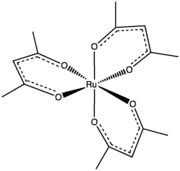Formula (C5H7O2)3Ru Density 1.54 g/cm³ Appearance Dark Violet Solid | Molar mass 398.39 g/mol Melting point 260 °C | |
 | ||
Ruthenium(III) acetylacetonate is a coordination complex with the formula Ru(O2C5H7)3. O2C5H7 is the ligand called acetylacetonate. This compound exists as a dark violet solid that is soluble in most organic solvents. It is used as a precursor to other compounds of ruthenium.
Contents
Preparation
In 1914 tris(acetylacetonato)ruthenium (III) was first prepared by the reaction of ruthenium(III) chloride and acetylacetone in the presence of potassium bicarbonate. Since then, alternative synthetic routes have been examined, but the original procedure remains useful with minor variations:
RuCl3•3H2O + MeCOCH2COMe → Ru(acac)3 + 3 HCl + 3 H2OStructure and properties
This compound has idealized D3 symmetry. Six oxygen atoms surround the central ruthenium atom in an octahedral arrangement. The average Ru-O bond length in Ru(acac)3 is 2.00 Å. Because Ru(acac)3 is low spin, there is one unpaired d electron, causing this compound to be paramagnetic. Ru(acac)3 has a magnetic susceptibility, χM, of 3.032×10−6 cm3/mol with an effective magnetic moment, μeff, of 1.66 μB. As a solution in DMF, the compound oxidizes at 0.593 and reduces at -1.223 V vs the ferrocene/ferrocenium couple.
Reduction of Ru(acac)3 in the presence of alkenes affords the related diolefin complexes. Typically, such reactions are conducted with zinc amalgam in moist tetrahydrofuran:
2 Ru(acac)3 + 4 alkene + Zn → 2 Ru(acac)2(alkene)2 + Zn(acac)2The resulting compounds are rare examples of metal-alkene complexes that reversibly sustain oxidation:
Ru(acac)2(alkene)2 ⇌ [Ru(acac)2(alkene)2]+ + e−